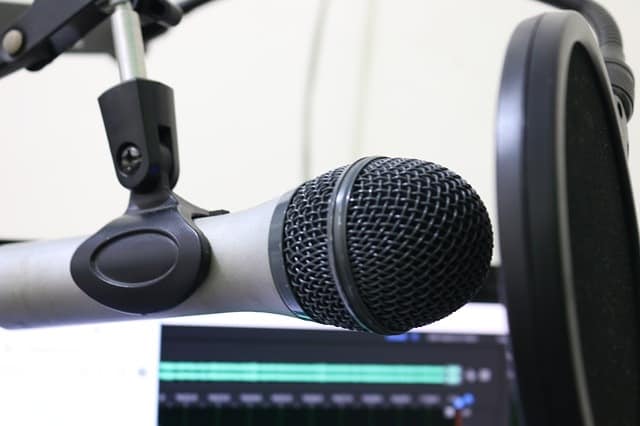4Podcasts have been growing by an astounding rate over the last few years. Starting a podcast can be an effective way to grow and expand your business, and you don’t need a ton of technical knowledge — or cash — to start one. Here’s what you need to know about creating a podcast people will love, without going broke in the process.
Step 1: Choose a Concept

The first step in creating your podcast is to decide on a concept. Consider what topics you want to explore, what you’d like to name your podcast, what the format will look like, and how long you wish each episode to be. Each episode should have its own premise that ties into the overall theme of your podcast. Most people choose to do their podcast about a topic they are an expert in or are passionate about.
Helpful Tip: Try to come up with a list of at least 10-15 episode ideas before committing to a topic or theme, in order to make sure you’ll have enough show ideas.
Keep in Mind: You’ll need artwork of some kind for your podcast in order to promote it.
Step 2: Decide on a Format
Once you have your podcast concept nailed down, you’ll need to decide on what format you’re going to use for each episode. There are several popular podcast formats, including:
- Interview style
- Solo
- Multiple hosts
- Narrative/Storytelling
- Hybrid (some combination of the above types)
Finally, decide how long each of your episodes will be. As a rule of thumb, an hour is about as long as you’ll want to go for a podcast. By keeping the length of each episode consistent, your listeners will know what to expect, and how much time to set aside, when they tune in.
Step 3: Purchase Any Supplies
While you can reasonably record and start your own podcast with nothing more than a smart phone, there are some items that can help make the process easier, and leave you with a higher quality product.
Microphone: High quality audio is important for a successful podcast, which makes investing a decent microphone worth the added expense. If budget is a big concern though, you can probably get by with just using the built-in microphone of your smartphone or computer, although it will be lower quality.
Headphones: While not necessary for a solo or narrative podcast, a good pair of headphones is important if you’re interviewing guests. Wearing headphones during the interview will help prevent your guest’s speech from coming through your speakers and being picked up by your microphone.
Hardware: You’ll want a computer for recording, editing, and uploading your podcast. Whether you choose a desktop or laptop model is mostly a matter of personal preference and budget.
Software: Having audio editing software can help you to edit your recordings for flow, time, and structure. There are free or low-cost options available, all the way to high-powered professional-grade tools. There is also call recording software available to record any interviews you might conduct.
Helpful Tip: Recording your file in MP3 format will make editing and uploading easier, as it compresses well and plays on most devices.
Step 4: Record an Episode
Once you have your concept and supplies, you’re ready to start recording your podcast! Plug your microphone into your computer, open your recording software, hit record and start talking.
Helpful Tip: Don’t worry about any mistakes or long pauses during the recording, as you can edit this later on. Remember that practice makes perfect when it comes to perfecting your speaking voice, especially for 20-30+ minute episodes.
Keep in Mind: During your first episode you’ll want to introduce yourself to your readers.
Step 5: Edit Your Audio
Congratulations! You’ve recorded your podcast episode. Now it’s time to edit your audio. You can add a pre-recorded intro and and outro track to the piece, remove any long silences, stabilize the volume, and cut out any mistakes you might have made. Once you’ve finished editing your podcast audio, save it as an MP3 file.
Helpful Tip: When saving your MP3 file, set it to a 128kbps bitrate and 44.1Mhz sample rate for the best playback in the smallest file size.
Step 6: Host Your Audio
Once you’ve got your finished podcast episode, you’ll need to upload it somewhere in order to distribute it for others to listen to. Take a look at how large your file is, and how many episodes you plan to record each month. Then, find a host that can handle the amount of bandwidth you’ll require.
Step 7: Syndicate Your Audio
Once your audio is hosted somewhere, you’ll need to syndicate the RSS feed in order to submit to directories — which is where people will go to discover and listen to your podcast. iTunes is one of the more popular directories, but there are many others. The good news is that most hosting services handle this step for you. Once you have an RSS feed created, your feed will be automatically updated on iTunes or elsewhere each time you upload a new episode.
Step 8: Submit to Directories
There are several popular directories where you can submit your podcast, including:
- iTunes
- SoundCloud
- Stitcher
- Spotify
- YouTube
- Google Play Music
Submitting your podcast to multiple directories is a good idea as it allows you to reach a larger audience.
That’s it — once you’ve got your podcast up and running, all that’s left is to promote it and grow your audience.
